Honor Award
Parkside Garden
San Francisco USA
Scott Lewis Landscape Architecture, San Francisco USA
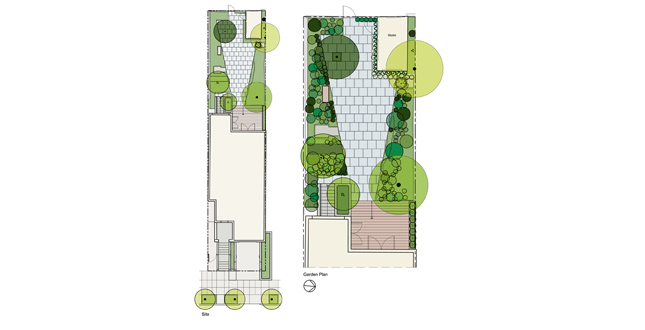 Close Me!
Close Me!Site Plan
Download Hi-Res ImagePhoto 1 of 16
 Close Me!
Close Me!The home’s interior space flows out into the garden. The steel framed door and window panels of the living room and adjacent dining room frame the outdoors where the lush plantings are visible throughout the year.
Download Hi-Res ImagePhoto: John Sutton Photography
Photo 2 of 16
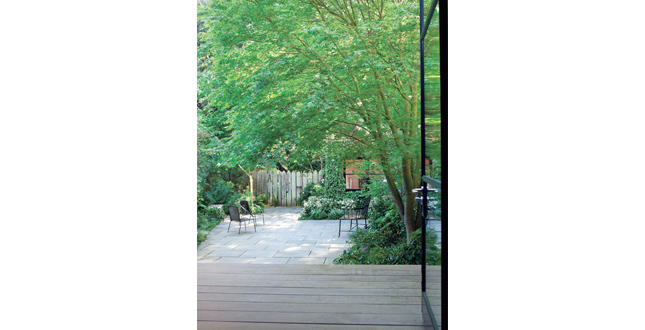 Close Me!
Close Me!At the edge of the house, the garden invites exploration. In the background is the ivy- covered art studio and beyond is a public park.
Download Hi-Res ImagePhoto: John Sutton Photography
Photo 3 of 16
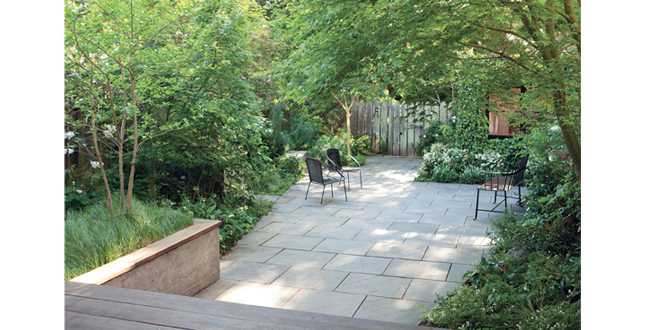 Close Me!
Close Me!Thornless hawthorn (Crataegus crus-galli var. inermis) and Carex pansa anchor the board-form concrete planter delineating the edge of a stairway. The wedge-shaped paving spreads out toward the back of the garden and the adjacent Presidio.
Download Hi-Res ImagePhoto: John Sutton Photography
Photo 4 of 16
 Close Me!
Close Me!This view from the master bedroom deck shows the balance between the sand-set paving and lush planting beds anchored with Japanese maples.
Download Hi-Res ImagePhoto: John Sutton Photography
Photo 5 of 16
 Close Me!
Close Me!The former storage shed was reused and made into an art studio. The landscape architect turned this structure into a “green cube” that is covered with ivy, which grows on a metal framework surrounding the studio.
Download Hi-Res ImagePhoto: John Sutton Photography
Photo 6 of 16
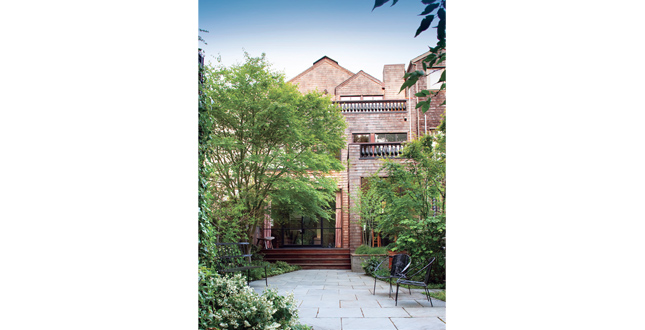 Close Me!
Close Me!The converging lines of the paving direct views back toward the living room, while the planting beds frame the edges of the scene. The garden was constructed around the specimen Japanese maple on the left.
Download Hi-Res ImagePhoto: John Sutton Photography
Photo 7 of 16
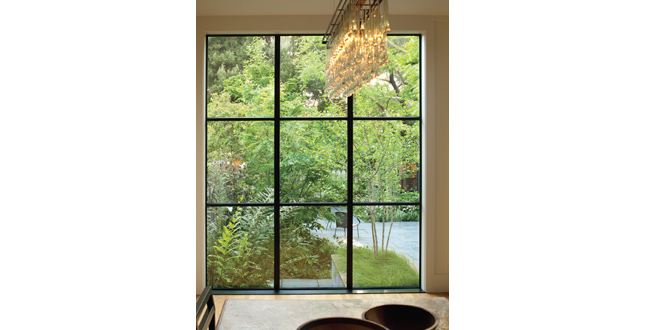 Close Me!
Close Me!The view from the family’s dining table includes the planting bed that holds shade-loving plants: Heuchera, Woodwardia, Sarcococca, Viola, etc. The soft Carex spills over the side of the planter that holds a multistemmed thornless hawthorn.
Download Hi-Res ImagePhoto: John Sutton Photography
Photo 8 of 16
 Close Me!
Close Me!The strong architectural forms and materials of the garden are softened and contrasted with the carefully textured plantings.
Download Hi-Res ImagePhoto: John Sutton Photography
Photo 9 of 16
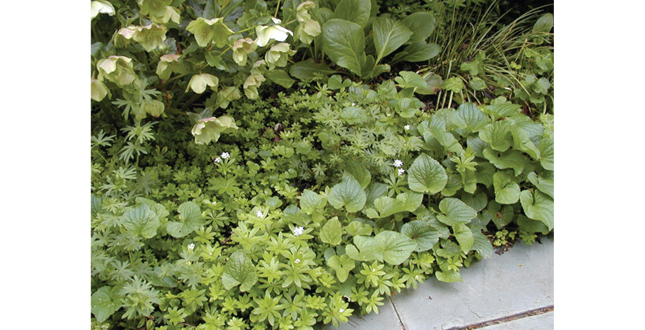 Close Me!
Close Me!The planting plan uses green and white plants and emphasizes texture. Here, Helleborus niger overhangs a ground cover mix with Bergenia 'Bressingham White,' Galium odoratum, Viola odorata 'White Czar,' Geranium sanguineum 'Album' and Acorus gramineus 'Variegata.'
Download Hi-Res ImagePhoto: John Sutton Photography
Photo 10 of 16
 Close Me!
Close Me!Dwarf conifers wee used to further accent the textual qualities of the garden: Pinus mugo ‘Humpy’ adds texture to a composition of Cyrtomium falcatum and Helleborus.
Download Hi-Res ImagePhoto: John Sutton Photography
Photo 11 of 16
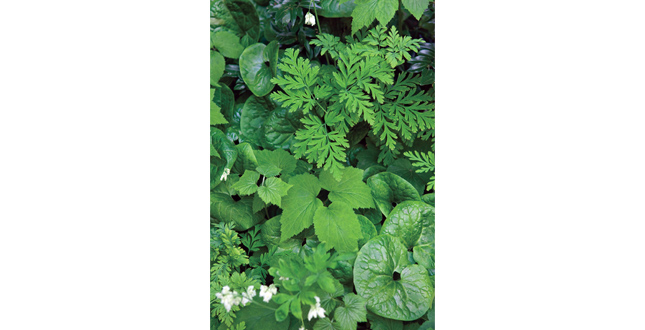 Close Me!
Close Me!Native white bleeding heart (Dicentra formosa 'Alba') is mixed with Asarum caudatum, Anemone japonica ‘Honorine Joubert,’ Galium odoratum and Sarcococca hookeriana humilis.
Download Hi-Res ImagePhoto: John Sutton Photography
Photo 12 of 16
 Close Me!
Close Me!The chartreuse green oval leaves of the espaliered Corylopsis spicata contrast to the lacy texture of the nearby Japanese maple and the broad leaves of the Bergenia below.
Download Hi-Res ImagePhoto: John Sutton Photography
Photo 13 of 16
 Close Me!
Close Me!White and green composition: Viburnum plicatum tomentosum 'Mariesii,' Alstroemeria puchella 'Variegated' and Deutzia 'Nikko.'
Download Hi-Res ImagePhoto: John Sutton Photography
Photo 14 of 16
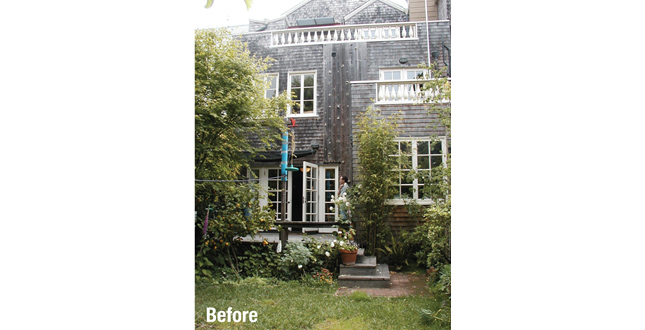 Close Me!
Close Me!Before renovation, the existing garden was an overgrown yard without a defined structure and limited usable outdoor space.
Download Hi-Res ImagePhoto: John Sutton Photography
Photo 15 of 16
 Close Me!
Close Me!Before renovation, the rear portion of the garden was a jumble of soggy grass and overgrown plantings and a lath-covered storage shed.
Download Hi-Res ImagePhoto: John Sutton Photography
Photo 16 of 16
Project Statement
This project proves that contemporary forms can join lush plantings to create an inviting environment. Bordering a wooded city park, this garden blends modern angles and green and white flora. A wedge-shaped terrace visually widens the site and extends the home's living area out toward the park. The property's art studio became a green cube focal point. The aesthetic of the home's modern interior is reflected in the distinctive lines of this refreshing garden.
Project Narrative
—2010 Professional Awards Jury
Project Location
The project involved the creation of an urban garden in conjunction with the extensive renovation of a shingle-style single-family residence in San Francisco. The site is adjacent to that city's heavily forested Presidio park.
Scope and Size
The extensive architectural renovation provided an opportunity to completely redo the landscape of this San Francisco row house and develop better connections to the park beyond. The narrow width of the 25-foot-wide lot was a challenge to achieving an interlocking spatial design.
Site and Context Investigation
The garden originally had a small lawn area and unique plants reflecting the owner's horticultural sensibilities. But, due to overgrown conditions, play areas for the young children were limited and the garden lacked a coherent visual structure. The family had little opportunity to use their outdoor space. However, the garden had good solar exposure, with the long axis of the garden running east–west. The tall eucalyptus and Monterey cypress in the Presidio park (which borders this garden) provided a good windbreak in this windy and foggy section of the city and the soil was quite sandy, with excellent drainage.
Design Program and Intent
The garden design had three main goals.
- First, the garden is intended to match the contemporary feel of the home's interior through strong forms, yet maintain a lush character. A modern tone was achieved by using angles, rather than square edges, to create a series of interesting shapes and perspectives within this small rectangular garden. The thick plantings, in turn, are either white or green. This palette keeps the emphasis on textures and forms, rather than introducing multicolored distractions to the garden's layout.
- The next objective was to extend the space and vistas from the living areas. This was accomplished by designing a deck at the floor level of the main living area that stepped down to a bluestone terrace. The terrace, in turn, then widened as it reached the back of the garden, which visually extended the space.
- Third, providing opportunities for many uses of the garden was a key goal. This was addressed by designing the flat terrace space for entertaining, by creating a studio for painting and sketching, and by crafting planting beds to hold favorite plants of the clients, who are avid gardeners.
Materials and Installation Methods
The stone paving is a simple two-by-two-foot module laid in a running bond pattern and set on an aggregate base with open joints. The joints allow stormwater to percolate through, the aggregate base dispenses with the need for rigid concrete slabs and the alternating joints of the running pattern contribute to the feel of the ever-expanding paving blending into the park beyond.
The selection and arrangement of the plant material was challenging. For instance, one side of the garden receives mostly full sun, but portions are shaded by the deciduous Japanese maple. The other side of the garden is mostly shaded, but one edge receives a significant amount of sun. Plants had to be a successful mix of white or green and have year-round interest. Finally, the plant masses had to fit within a bed width that varies from 18 inches to 6foot within the wedges.
Environmental Impact and Concerns
Reuse, local and recycled materials were important components of the plan. The former garden shed was converted into an eye-catching art studio by encasing it in an ivy-covered framework. The resulting green cube makes for an alluring part of the home's garden view. In another example of reuse, antique stone curbs from the previous garden were reused to form benches and steps. Local craftspeople were selected to supply the colorful concrete pots and the garden chairs made from recycled oil drums.
Minimizing water use for irrigation was an important part of the program. Fortunately, the cool San Francisco summers cut down on evaporation. Combined with the use of organic compost and amendments, the plants are able to thrive on intermittent drip irrigation during the summer and do not need any irrigation during the rainy winters.
The preservation of the existing specimen trees and plants were critical factors in the design. The layout was adjusted to minimize disturbance to the mature trees and plants that remained. Also, the client reports sighting birds from the neighboring park who enjoy the density and variety of the plantings. Hummingbirds, finches and warblers are regular visitors to the garden.
Regarding environmental impacts, all stormwater had to be contained within the garden and local and recycled components were used where feasible.
Collaboration with the Client and Other Designers
The landscape architect and the owner worked closely together in the design phases, considering several options before selecting the wedged terrace idea. The owner's extensive knowledge and interest in plants made the plant selection and field arrangements a uniquely satisfying experience for the entire team.
Project Resources
Scott Lewis Landscape Architecture
Design Team
Scott R. Lewis, ASLA, Principal
Martha A. Folger, Project Manager
Jennifer A. de Graaf
Architect
Malcolm Davis Architecture
Malcolm Davis
Quinn Morgan
Landscape Contractor
Hien Landscaping
General Contractor
Jeff King and Company
Cast Concrete Pot
Mary Martha Collins
Site Furniture
Owner's collection
Specimen and Specialty Plants
Sweet Lane Wholesale Nursery
Pacific Nurseries
Forest Farm Nursery
W. C. Fields Nursery
Geraniaceae






